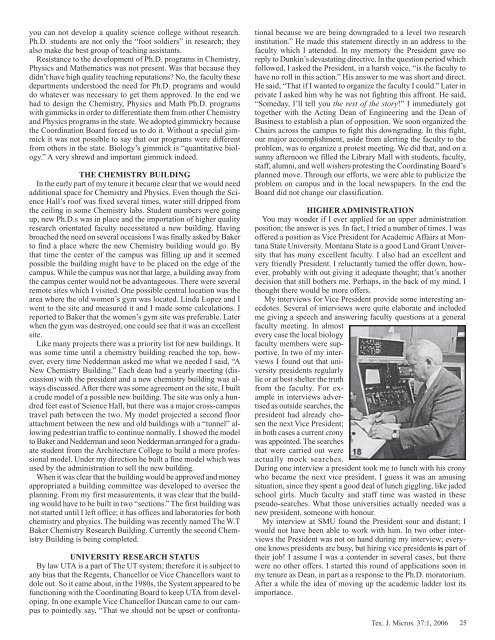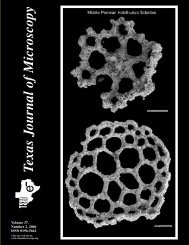Texas Journal of Microscopy Texas Journal of Microscopy
Texas Journal of Microscopy Texas Journal of Microscopy
Texas Journal of Microscopy Texas Journal of Microscopy
You also want an ePaper? Increase the reach of your titles
YUMPU automatically turns print PDFs into web optimized ePapers that Google loves.
you can not develop a quality science college without research.<br />
Ph.D. students are not only the “foot soldiers” in research; they<br />
also make the best group <strong>of</strong> teaching assistants.<br />
Resistance to the development <strong>of</strong> Ph.D. programs in Chemistry,<br />
Physics and Mathematics was not present. Was that because they<br />
didn’t have high quality teaching reputations? No, the faculty these<br />
departments understood the need for Ph.D. programs and would<br />
do whatever was necessary to get them approved. In the end we<br />
had to design the Chemistry, Physics and Math Ph.D. programs<br />
with gimmicks in order to differentiate them from other Chemistry<br />
and Physics programs in the state. We adopted gimmickry because<br />
the Coordination Board forced us to do it. Without a special gimmick<br />
it was not possible to say that our programs were different<br />
from others in the state. Biology’s gimmick is “quantitative biology.”<br />
A very shrewd and important gimmick indeed.<br />
THE CHEMISTRY BUILDING<br />
In the early part <strong>of</strong> my tenure it became clear that we would need<br />
additional space for Chemistry and Physics. Even though the Science<br />
Hall’s ro<strong>of</strong> was fixed several times, water still dripped from<br />
the ceiling in some Chemistry labs. Student numbers were going<br />
up, new Ph.D.s was in place and the importation <strong>of</strong> higher quality<br />
research orientated faculty necessitated a new building. Having<br />
broached the need on several occasions I was finally asked by Baker<br />
to find a place where the new Chemistry building would go. By<br />
that time the center <strong>of</strong> the campus was filling up and it seemed<br />
possible the building might have to be placed on the edge <strong>of</strong> the<br />
campus. While the campus was not that large, a building away from<br />
the campus center would not be advantageous. There were several<br />
remote sites which I visited. One possible central location was the<br />
area where the old women’s gym was located. Linda Lopez and I<br />
went to the site and measured it and I made some calculations. I<br />
reported to Baker that the women’s gym site was preferable. Later<br />
when the gym was destroyed, one could see that it was an excellent<br />
site.<br />
Like many projects there was a priority list for new buildings. It<br />
was some time until a chemistry building reached the top, however,<br />
every time Nedderman asked me what we needed I said, “A<br />
New Chemistry Building.” Each dean had a yearly meeting (discussion)<br />
with the president and a new chemistry building was always<br />
discussed. After there was some agreement on the site, I built<br />
a crude model <strong>of</strong> a possible new building. The site was only a hundred<br />
feet east <strong>of</strong> Science Hall, but there was a major cross-campus<br />
travel path between the two. My model projected a second floor<br />
attachment between the new and old buildings with a “tunnel” allowing<br />
pedestrian traffic to continue normally. I showed the model<br />
to Baker and Nedderman and soon Nedderman arranged for a graduate<br />
student from the Architecture College to build a more pr<strong>of</strong>essional<br />
model. Under my direction he built a fine model which was<br />
used by the administration to sell the new building.<br />
When it was clear that the building would be approved and money<br />
appropriated a building committee was developed to oversee the<br />
planning. From my first measurements, it was clear that the building<br />
would have to be built in two “sections.” The first building was<br />
not started until I left <strong>of</strong>fice; it has <strong>of</strong>fices and laboratories for both<br />
chemistry and physics. The building was recently named The W.T<br />
Baker Chemistry Research Building. Currently the second Chemistry<br />
Building is being completed.<br />
UNIVERSITY RESEARCH STATUS<br />
By law UTA is a part <strong>of</strong> The UT system; therefore it is subject to<br />
any bias that the Regents, Chancellor or Vice Chancellors want to<br />
dole out. So it came about, in the 1980s, the System appeared to be<br />
functioning with the Coordinating Board to keep UTA from developing.<br />
In one example Vice Chancellor Duncan came to our campus<br />
to pointedly say, “That we should not be upset or confronta-<br />
tional because we are being downgraded to a level two research<br />
institution.” He made this statement directly in an address to the<br />
faculty which I attended. In my memory the President gave no<br />
reply to Dunkin’s devastating directive. In the question period which<br />
followed, I asked the President, in a harsh voice, “is the faculty to<br />
have no roll in this action.” His answer to me was short and direct.<br />
He said, “That if I wanted to organize the faculty I could.” Later in<br />
private I asked him why he was not fighting this affront. He said,<br />
“Someday, I’ll tell you the rest <strong>of</strong> the story!” I immediately got<br />
together with the Acting Dean <strong>of</strong> Engineering and the Dean <strong>of</strong><br />
Business to establish a plan <strong>of</strong> opposition. We soon organized the<br />
Chairs across the campus to fight this downgrading. In this fight,<br />
our major accomplishment, aside from alerting the faculty to the<br />
problem, was to organize a protest meeting. We did that, and on a<br />
sunny afternoon we filled the Library Mall with students, faculty,<br />
staff, alumni, and well wishers protesting the Coordinating Board’s<br />
planned move. Through our efforts, we were able to publicize the<br />
problem on campus and in the local newspapers. In the end the<br />
Board did not change our classification.<br />
HIGHER ADMINISTRATION<br />
You may wonder if I ever applied for an upper administration<br />
position; the answer is yes. In fact, I tried a number <strong>of</strong> times. I was<br />
<strong>of</strong>fered a position as Vice President for Academic Affairs at Montana<br />
State University. Montana State is a good Land Grant University<br />
that has many excellent faculty. I also had an excellent and<br />
very friendly President. I reluctantly turned the <strong>of</strong>fer down, however,<br />
probably with out giving it adequate thought; that’s another<br />
decision that still bothers me. Perhaps, in the back <strong>of</strong> my mind, I<br />
thought there would be more <strong>of</strong>fers.<br />
My interviews for Vice President provide some interesting anecdotes.<br />
Several <strong>of</strong> interviews were quite elaborate and included<br />
me giving a speech and answering faculty questions at a general<br />
faculty meeting. In almost<br />
every case the local biology<br />
faculty members were supportive.<br />
In two <strong>of</strong> my interviews<br />
I found out that university<br />
presidents regularly<br />
lie or at best shelter the truth<br />
from the faculty. For example<br />
in interviews advertised<br />
as outside searches, the<br />
president had already chosen<br />
the next Vice President;<br />
in both cases a current crony<br />
was appointed. The searches<br />
that were carried out were<br />
actually mock searches.<br />
During one interview a president took me to lunch with his crony<br />
who became the next vice president. I guess it was an amusing<br />
situation, since they spent a good deal <strong>of</strong> lunch giggling, like jaded<br />
school girls. Much faculty and staff time was wasted in these<br />
pseudo-searches. What those universities actually needed was a<br />
new president, someone with honour.<br />
My interview at SMU found the President sour and distant; I<br />
would not have been able to work with him. In two other interviews<br />
the President was not on hand during my interview; everyone<br />
knows presidents are busy, but hiring vice presidents is part <strong>of</strong><br />
their job! I assume I was a contender in several cases, but there<br />
were no other <strong>of</strong>fers. I started this round <strong>of</strong> applications soon in<br />
my tenure as Dean, in part as a response to the Ph.D. moratorium.<br />
After a while the idea <strong>of</strong> moving up the academic ladder lost its<br />
importance.<br />
Tex. J. Micros. 37:1, 2006<br />
25




